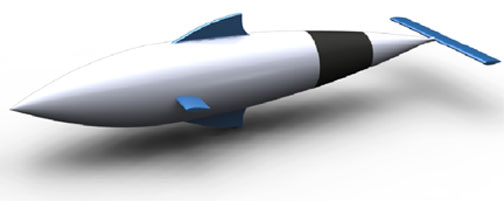Mechanical Swimmer Project
- A. Ariel, T. Briller, L. Gal, O. Gashri, D. Komornik, R. Sayag
- Prof. Gil Iosilevskii

Summary
Our goal was to design a mechanical fish that is capable of swimming at 5 body lengths per second. Not many aquatic animals have been adapted to reach this speed. The fastest swimmers invariably have high-aspect-ratio caudal fins, slim peduncles and long and narrow bodies. They use carangiform or thunniform types of locomotion, where only the rear part of the body moves to propel the fish. Dolphins and tunas are representative examples. Assuming that the Nature cannot be terribly wrong in its design, we have followed the design of a dolphin. It required a comprehensive biological and hydro-dynamical study. Practically all areas of aeronautical engineering had to be addressed: hydrodynamics, dynamics, control, mechanics and heat transfer. Lacking ‘of-the-shelf’ design tools, the design was based mainly on simulations.
Goal and Motivation
The design needed to fulfill the following requirement:
1. Cruise speed of one body length per second for 25 minutes.
2. Maximal speed of 5 body lengths per second for 5 minutes.
3. Maximal turn radius of 5 meters.
4. Maximal working depth – 10 meters.
Existing mechanical designs hardly met a top speed of one body length per second. Apart from the challenge, the project’s uniqueness was good enough a reason to undertake it. It was certainly different from a typical final project at our Faculty.
Design
Numerous 3DOF simulations were conducted to study free-body caudal fin propulsion. The study addressed the effects of various parameters (such as fins’ geometry and position, body size, peduncle flexibility, body motion amplitude etc.) on propulsion efficiency, instantaneous power consumption and longitudinal stability. In addition, turning mechanisms like thrust vectoring were tested and analyzed.
It was found that pectoral fins have practically no effect on propulsion efficiency (but affect stability); for best efficiency the peduncle flexibility should decrease with dynamic pressure; tail amplitude alone cannot be used to control the power; maximal instantaneous power required during the beat cycle exceeds the average power almost two-fold. Variable peduncle flexibility and flywheel turned out to be necessities. It was also found that 5o deflection of thrust, combined with drag of one of the pectoral fins are sufficient to achieve the required turn radius.
The power needed to achieve the speed of five body lengths per second increases with the body length at the fifth power, and therefore a small fish has a huge power advantage over a large one. On the other hand, the design should have enough volume to accommodate all its components and float them. It also should have its caudal fin operating at sufficiently high Reynolds number to avoid its premature stall. Considering all the requirements and the constraints we chose the body length of 1 meter.
Based on simulations the requirements can be fulfilled with the proposed design.








